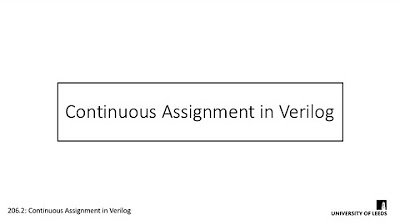Introduction to Sequential Circuits | Digital Electronics
Summary
TLDRIn this informative video, viewers are introduced to sequential circuits, distinguishing them from combinational circuits commonly found in digital electronics. The presenter explains how sequential circuits rely on both present and past inputs, emphasizing the importance of memory elements. Using a relatable analogy of changing television channels, the video illustrates the functionality of sequential circuits, including synchronous and asynchronous types. It also delves into clock signals and their influence on circuit behavior, highlighting key concepts like duty cycles and edge-triggered versus level-triggered responses. This foundational overview sets the stage for deeper exploration of flip-flops and related components in future videos.
Takeaways
- 😀 Sequential circuits are essential in digital electronics, integrating memory to retain past inputs alongside current ones.
- 🔄 Unlike combinational circuits, where outputs depend solely on present inputs, sequential circuits consider both current and historical data.
- 📺 The example of a television remote illustrates how pressing a button not only influences the next channel but relies on the current channel stored in memory.
- 🛠️ The structure of sequential circuits includes a combinational circuit block and memory elements, enabling feedback and state retention.
- ⏰ Sequential circuits can be categorized into two types: synchronous (responding at discrete intervals) and asynchronous (responding immediately to input changes).
- 🕰️ The clock signal is crucial for synchronous circuits, dictating when memory elements can respond to input changes.
- 📏 Key clock signal terms include time period, ON time, OFF time, and duty cycle, which define the behavior of these circuits.
- 💾 Flip-flops serve as fundamental memory elements, capable of storing a single bit of information (0 or 1) in sequential circuits.
- 🔗 The video emphasizes the importance of propagation delay in determining the maximum operating frequency for synchronous circuits.
- 🔍 Future videos will explore various types of flip-flops in detail, enhancing understanding of sequential circuits and their applications.
Q & A
What are the key differences between combinational circuits and sequential circuits?
-Combinational circuits produce outputs solely based on current inputs, while sequential circuits generate outputs based on both current and past inputs, requiring memory elements.
Can you provide an example of a combinational circuit?
-Examples of combinational circuits include adders, encoders, and multiplexers, where the output is determined only by the present inputs.
How do sequential circuits use memory elements?
-Sequential circuits use memory elements to store past inputs, which influences the output along with the current input, allowing them to maintain a state.
What role does the clock signal play in synchronous sequential circuits?
-The clock signal in synchronous sequential circuits dictates when the memory elements should respond to changes in input, ensuring that they update at discrete time intervals.
What is the difference between level triggered and edge triggered circuits?
-Level triggered circuits respond to inputs as long as the clock signal is high, while edge triggered circuits only respond at specific transitions (rising or falling edges) of the clock signal.
What are the characteristics of a clock signal?
-A clock signal is a periodic train of pulses that alternates between high and low voltage levels, with key characteristics including time period, ON time, OFF time, and duty cycle.
What is a flip-flop and why is it important in sequential circuits?
-A flip-flop is a basic memory element that can store one bit of information. It is crucial for building sequential circuits like registers and counters, enabling them to maintain state information.
What does the duty cycle of a clock signal represent?
-The duty cycle is the ratio of the ON time to the total time period of a clock signal, indicating how long the signal remains high compared to its entire cycle.
Why is it necessary for sequential circuits to consider past inputs?
-Considering past inputs allows sequential circuits to perform operations that depend on the history of input states, enabling more complex functionalities like counting or state retention.
How does changing a television channel illustrate the function of sequential circuits?
-Changing a TV channel using a remote illustrates sequential circuits as the next channel displayed depends not only on the button pressed but also on the current channel being viewed, showcasing the dependence on both present and past states.
Outlines

This section is available to paid users only. Please upgrade to access this part.
Upgrade NowMindmap

This section is available to paid users only. Please upgrade to access this part.
Upgrade NowKeywords

This section is available to paid users only. Please upgrade to access this part.
Upgrade NowHighlights

This section is available to paid users only. Please upgrade to access this part.
Upgrade NowTranscripts

This section is available to paid users only. Please upgrade to access this part.
Upgrade NowBrowse More Related Video

Introduction to Sequential Circuits | Important

FLIP-FLOP - Jenis dan tabel kebenaran

Digital Electronics (DE) All 5 Units Important Questions AKTU BOE310/BOE410 & BEE401 B.Tech 2nd Year

Pertemuan 1 - Mata Kuliah Rangkaian Digital- TA 25/26 Ganjil - UNUSIDA

Continuous Assignment in Verilog

Introdução a Conceitos de Computação - Portas lógicas e expressões booleanas
5.0 / 5 (0 votes)